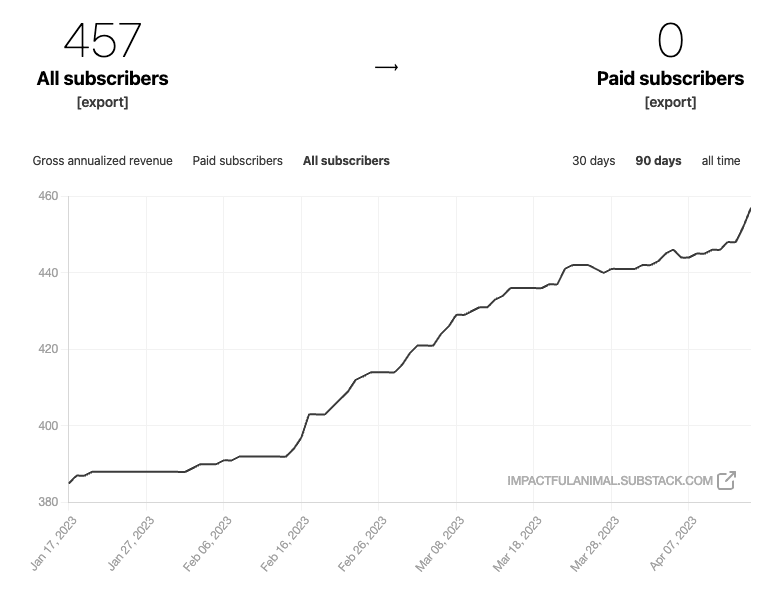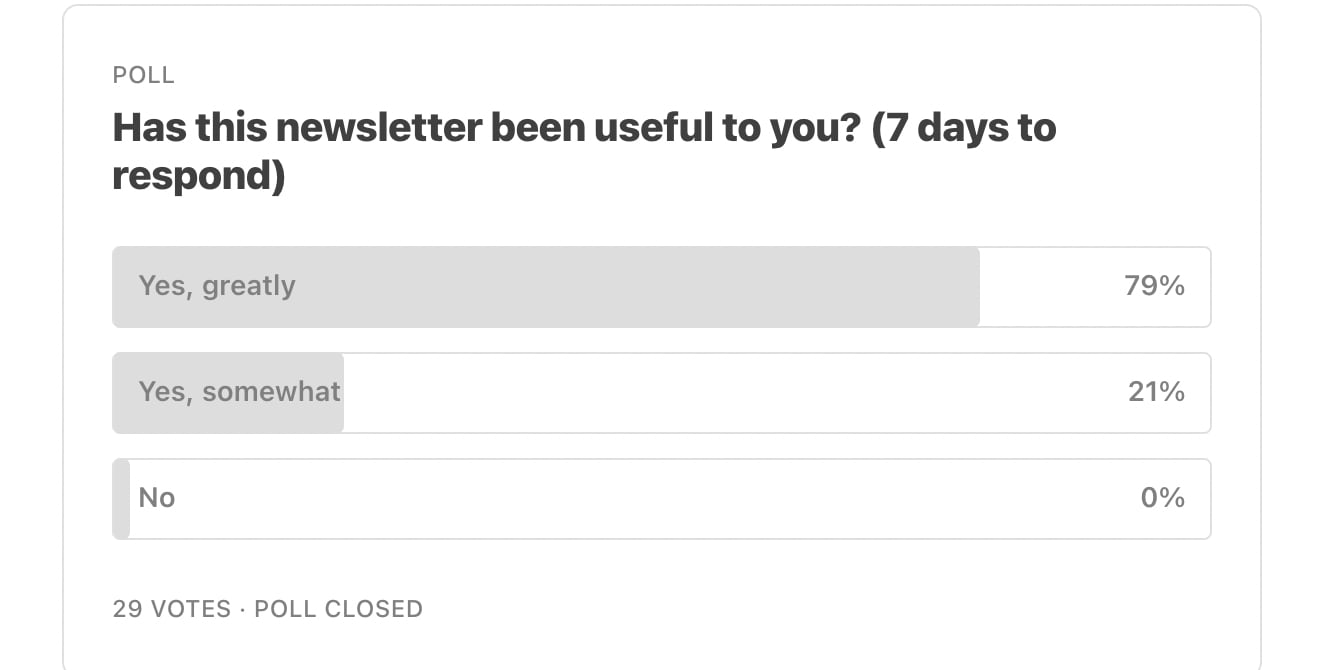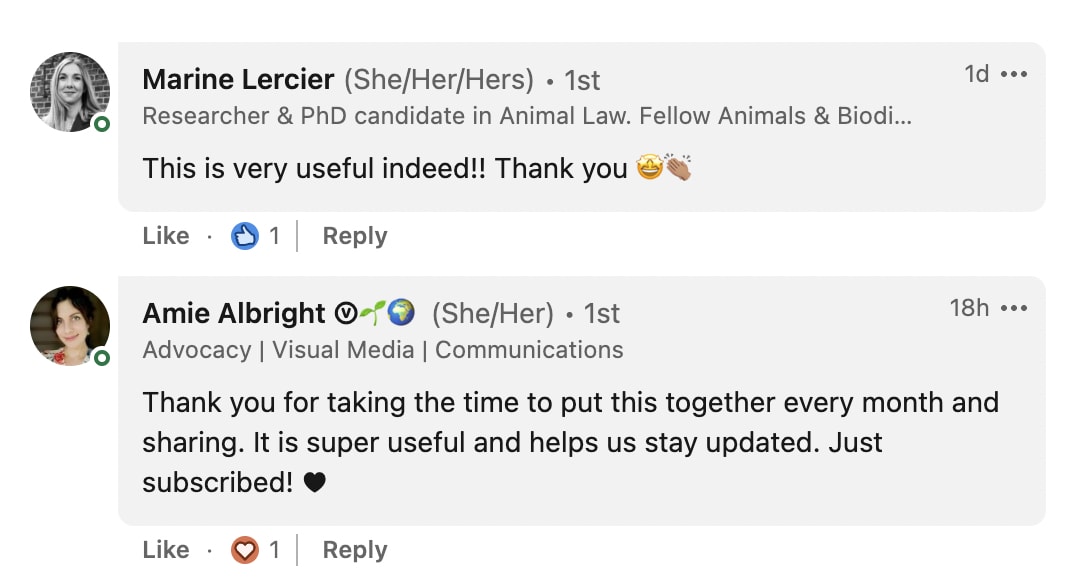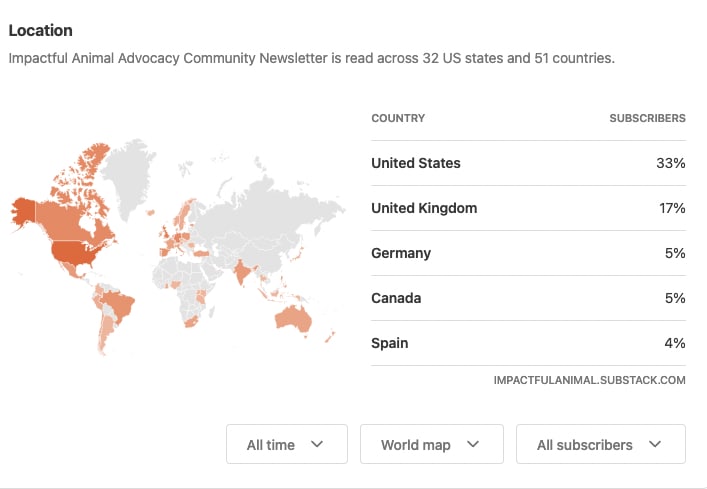Starting and running your own mini projects: What I've learnt running a newsletter for a year
By SofiaBalderson @ 2023-04-16T17:35 (+62)
Tl;dr:
- There are many unmet needs in the movement that you can fill with a couple of hours a month (without anyone’s permission)
- My project - the newsletter itself was relatively easy to put together (2-4h a month basic running) and now has 457 subscribers (and counting!)
- The open rates are amazingly high: over 62% consistently
- It’s really tempting to give up: please give new projects feedback and encouragement
My Story: how and why I started it
I like to be aware of opportunities in animal advocacy and when I see something interesting, I usually can think of a couple of friends who might find it useful. After a couple of years of sending links to a growing network of friends, I realised that I’m spending A LOT of time sharing resources. I thought to myself, why not start a newsletter where I’d put all these opportunities and then can invite my network to sign up. So at first it was a time-saving opportunity. But also I noticed that existing animal advocates are in closed spaces and groups and all the best opportunities are posted there, while there are lot of new and existing animal advocates who don’t have access to these groups. I thought it wasn’t very inclusive and decided to create something that’s open to everybody.
Some (very nice!) feedback I got:
- Reader surveys
- I ran a very easy, press of a button survey in autumn, and most people said they found the newsletter useful (albeit a very small sample size of 29 and a bias towards most active users, but that just shows how people don’t have time for surveys, as I sent a Google Form that didn't get many answers at all)
Individual positive feedback:
"I'm so grateful for the newsletter - I've been listening to the podcasts recommended in it during my work hours, and read posts with a cuppa in the mornings/evenings. Loving the resource as it covers so many different aspects and areas within EAA. It'll be heavily used by me as I want to learn as much as I can about the community as I figure out what career in EAA would be a good fit" - Shaileen McGovern, Department of Agriculture, Food and the Marine, Ireland.
From Andrés Jiménez Zorrilla, CEO at the Shimp Welfare Project:
“For your poll [above], the only negative I have is that I open a dozen new tabs of things to read when I should be working! More seriously, this aggregation of news and events is at the very list inspiring to continue my own activism” - Josh Baldwin.
Some stats:
- The newsletter consistently has on average 62.5% open rate. It started with 80% open rate on the second edition (the one that was the first edition for about half the subscribers to receive, then it gradually went down and it’s been consistent for about 6 months).
- At the time of writing the newsletter has 457 subscribers. I had a big jump at the launch to just under 200 and then consistently arrived at over 400. I haven't done much promotion until about a week ago (hence the spike).

The country composition is very interesting, mainly US and UK, but also Germany, Spain and other countries.
What I’ve learnt:
- If you have a good idea that is based on an actual problem/unmet need, just do it.
- Don’t listen to your own voice that tells you “No one needs it” or others saying it’s already been done. Check if it has really been done, or if people just think it has. If it has been done, has it been done well enough?
- If you need some help identifying a problem, listen to people's conversations online and see what people often complain about. Do they lack IT support? HR consultancy? No time to do ops?
- Don’t spend too much time thinking about counterfactuals. I know that EAs love to discuss whether this is really the best use of your time. But I think every month spent discussing is a month of impact wasted. I spent about two weeks from idea concept to publishing my newsletter and telling everyone about it. Especially for a project that will take relatively little time.
- Process is important:
- I had very little time to do this project, so I created a form to help me collect the news and a project in Notion that helped organise them all. Substack, the newsletter software, is very easy and intuitive to use (and it’s free!)
- I had to ask people who emailed me with news to fill in the form instead a couple of times, which was awkward but it helped me a lot not to lose information.
- Thinking about the future, I’ll probably use Zapier to get the submissions directly into Notion.
- Process-thinking over achievement-thinking: We can achieve so much just by taking a small action over a long period of time. I love looking at the subscription growth graph above!
- Impostor syndrome is real and normal (and it’s not going anywhere)
- I told myself many times “Who am I to create a newsletter for all things animal advocacy?” But then, people told me they find it insightful and I thought “If I don’t do it, likely no one will”
- Some things are really quick to do and they can surprisingly impactful
- I collect content throughout the month as I encounter it (takes seconds), then I spend 2-3 hours putting it together and proofreading.
- People told me they use it as their fast way to get up to speed with what’s going on because they are in busy roles, some people tell me they’d never find the resource if not for my newsletter.
- For some projects, you don’t need funding, or at least, you don’t need a lot
- I’ve heard that people are being discouraged from starting new charities in the animal welfare space due the funding constraints. However, you don’t need to start a new charity to help solve a problem. If many of us started mini projects, maybe 10 people could solve problems that a whole charity would.
- When running projects on your own, it’s easy to give up.
- Especially when there is no feedback on how it’s being received, and no payment for your time, is really hard. I wanted to give up after about 3 editions because I was very busy with my full-time job at Animal Advocacy Careers and ended up working on it while tired on a weekend.
- Positive feedback and stats monitoring is very important not to give up
- When I considered not running the newsletter after a couple of months, a number of things kept me going.
- Positive feedback
- Getting notified via email every time someone new signs up
- Donations - I got a couple of small donations, for which I’m really grateful! It made me feel that people value my work enough to put money into it.
- Seeing stats, e.g. open rates, which links were the best etc.
- When I considered not running the newsletter after a couple of months, a number of things kept me going.
- You’ll never know where it will lead
- During a retreat, I spoke to Cameron who is also very passionate about community building. Together we launched an addition to this newsletter: A community Slack space, which now has nearly 400 people. This project is also really fun to work on, and seems like people really need it, and I’d probably never do it if I didn’t do the newsletter.
- There may be some additional surprise bonuses
- E.g. I get people thanking me for the newsletter pretty much any time someone new introduces themselves to me, even if I don’t know them or their work yet. I guess it’s a good way to get your name out there.
- I’m not looking for a role now but I think it’s a fantastic way to get a job as people will know you and your work better.
- Keep spreading the word.
- When you run a project, don't assume everyone knows about it just because you posted about it on the Forum or on LinkedIn once. People need reminders, people are busy and won't always pay attention right away.
- I realised I have to make the newsletter visible as much as possible. E.g. I included it in my email signature, I started posting about it on LinkedIn regularly, and I now tell all my new connections about it.
My current challenges:
- I’d love to get to 600 subscribers this year, ideally more. I'm getting about 30 people a month at the moment.
- I’d love to attract new community members to speed up their access to resources and hence their work. I'm currently in the process of creating audiences and posting about the newsletter as much as time allows me.
- I’d love to attract readers from more countries, although admittedly, the language is a barrier for that.
- Impact evaluation - even though I did get feedback, it’s hard to evaluate it. Because it’s technically a very meta project, there is no way I can accurately quantify impact for the animals. I can see how many people opened the newsletter and which links, but past that, it’s much harder. I tried surveys and got a couple of responses but people are too busy to respond.
- While I can’t see how many people have unsubscribed over time in my plan, there can’t be that many as you can see that the graph doesn’t have many dips in it at all. This means that the majority of people are happy enough with the newsletter to keep getting it (or just can’t be bothered to unsubscribe of course).
- As a mentioned above, Cameron and I are fundraising for our Slack space - a great addition to the newsletter! A premium subscription to allow us to keep the history past 90 days. It costs just over $1700 a year for current members and any contribution towards that will help greatly. Please DM me if you're interested in supporting us with this or donate here!
How you can help:
- If you haven't already, subscribe to the newsletter!
- Help get more subscribers, especially from a diverse group: One idea I am trialing is to post mini content bits from the newsletter on LinkedIn and other communities where people might benefit from the newsletter. DM me if you have any other ideas!
- Spread the word: if your friend/colleague/team doesn’t yet know about the newsletter please share it!
- Donate if you wish/can: any funds will help me spend more time on promoting the newsletter, potentially even running some ads/asking influencers to promote it
- Give me feedback about the newsletter: I’m always keen to improve it!
- Submit news to the newsletter via the form
Conclusion:
I hope that it was an interesting read and that you got inspired to start a mini project (if you see a need to!) Let me know if you have any questions or comments!
Josh Baldwin @ 2023-04-18T01:36 (+4)
Been subscribed for a while. So glad to see your newsletter is growing!



